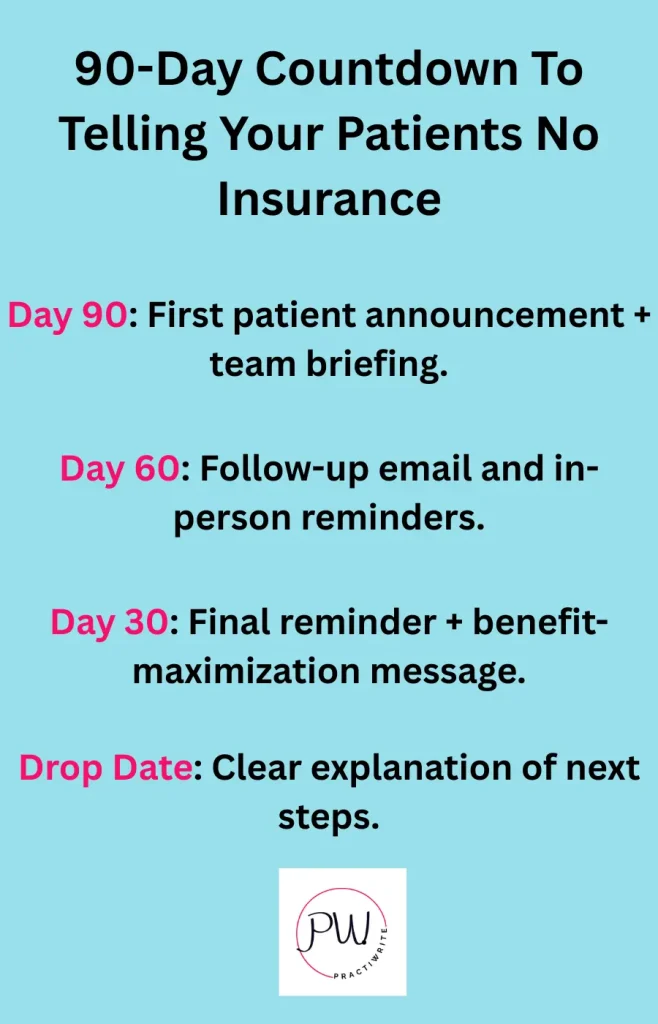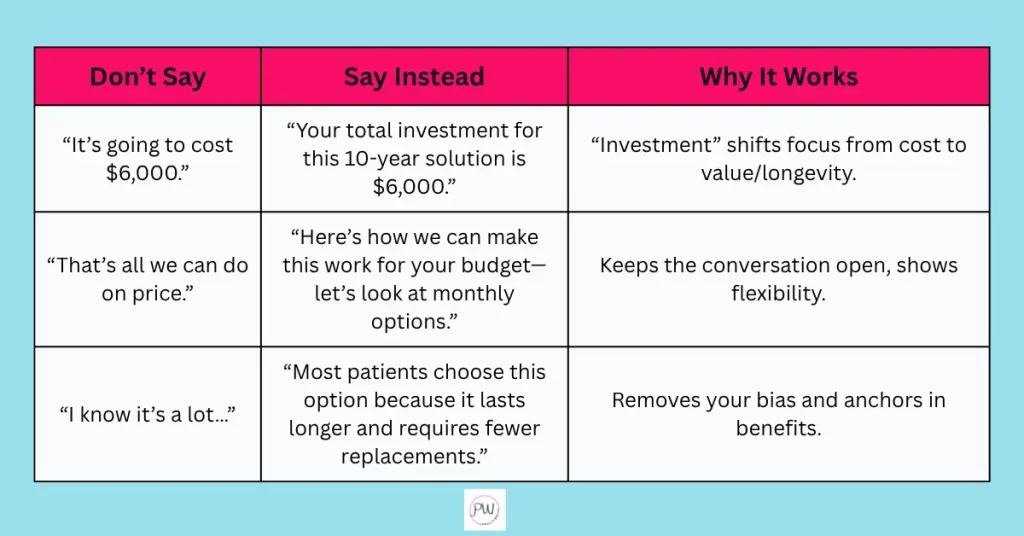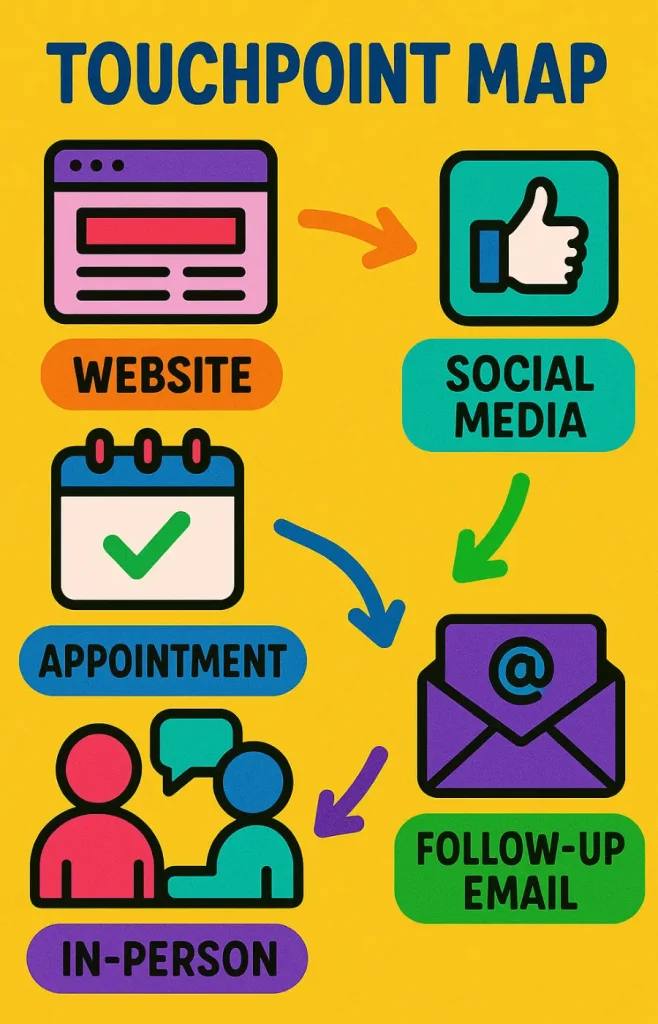Telling patients you’re dropping their insurance plan feels like the dental equivalent of breaking up with someone who still really likes you.
You know it’s the right move for your practice.
You know it’ll give you the freedom to deliver the kind of care you believe in.
But that doesn’t stop the knot in your stomach when you picture the first patient frowning back at you and asking, “Wait… you don’t take my insurance anymore?”
Most dentists dread this moment so much they either:
- Put it off until the last possible second.
- Send a dry, legal-sounding letter that sounds like it came from their accountant.
- Fumble through an awkward explanation that leaves the patient confused—or worse, suspicious.
The truth is that dropping an insurance plan is a brand statement, not just a policy change.
And if you handle it right, it can increase patient loyalty instead of killing it.
The key? You need a clear, empathetic, and confident script that communicates the change without apologizing for it.
Let’s see exactly how to tell patients no insurance:
- When and how to break the news so you don’t blindside patients.
- Scripts your whole team can use (because every staff member should be saying the same thing).
- How to frame the benefits so patients see this as a win for them, not just for you.
- Real-world examples of practices that pulled this off without losing their patient base.
This isn’t about spinning the truth.
It’s about telling the truth in a way that builds trust, keeps your schedule full, and sets your Fee-For-Service future up for success.
Table of Contents
Why Communication Matters When Dropping Insurance
Dropping an insurance plan is one of those moments that can either strengthen your relationship with patients… or shatter it. The difference comes down to how you communicate.
When patients feel blindsided or confused, they default to worst-case thinking:
- “Are you in financial trouble?”
- “Are you just trying to make more money off me?”
- “Does this mean I can’t see you anymore?”
Most patients don’t actually understand how dental insurance works in the first place. A 2023 ADA survey found that nearly half of dental patients believe their plan covers “most” of their costs, when in reality the average plan covers less than 50% of total treatment fees.
That misunderstanding is your biggest communication challenge, and opportunity.
When you drop an insurance plan, the goal isn’t just to announce it. It’s to reframe the change:
- You’re freeing patients from insurance company treatment restrictions.
- You’re able to offer more personalized, higher-quality care.
- You’re still committed to helping them maximize any benefits they have—just without the red tape.
According to Gallup research on trust in healthcare, transparency is the number-one driver of patient trust. That means the more direct, clear, and honest you are, the more likely patients are to stay with you, even if they have to file their own claims.
And here’s what we’ve seen time and time again in successful Fee-For-Service transitions:
- Practices that clearly explain the why behind the change retain 70–85% of their patients after dropping a plan.
- Practices that simply “make the announcement” without framing the benefits? Retention rates drop below 50%.
If you want to stay in that first category, every word you and your team say matters and it has to be consistent, confident, and empathetic from day one.
When Is the Right Time to Tell Patients?
The short answer: earlier than you think.
Most dentists underestimate how much time patients need to process an insurance change. They either drop the news a few weeks before the contract ends or worse, spring it on patients when they show up for their next cleaning.
That’s a surefire way to trigger panic, frustration, and patient loss.
The sweet spot? At least 60–90 days’ notice before you officially go out-of-network.
Here’s why that window works:
- It gives your team time to communicate consistently across all patient touchpoints (phone calls, in-office visits, emails, and mailed letters).
- It allows patients to ask questions before their next appointment, so they’re not processing the change and deciding about treatment in the same conversation.
- It gives you room to reframe and reinforce your message multiple times, which builds acceptance.
In change management research, repetition is everything. One study from McKinsey & Company found that people need to hear a new message at least seven times before it fully registers and sticks.
Your patients are no different. They need consistent, repeated exposure to your new message to feel comfortable with it.
Practiwrite Tip: If you have patients scheduled after your drop date, call them personally (don’t leave it to an automated reminder). This personal touch signals that you value the relationship and are committed to helping them through the change.

Prepping Your Team: Everyone Needs the Same Script
You can’t expect patients to stay confident about your practice if your own team sounds unsure about what’s happening. The fastest way to tank your patient retention during an insurance drop is to have staff giving mixed messages or worse, sounding apologetic.
Here’s the rule: one message, one voice, every time.
Why this matters:
- Patients trust consistency. A PwC Health Research Institute survey found that 64% of patients say they would switch providers if they felt communication was unclear or inconsistent.
- Inconsistent explanations breed doubt. If a hygienist says, “We’re dropping your plan, but I’m not sure why,” that undermines all the careful framing you’ve done.
Step 1: Hold an All-Hands Meeting Before You Tell Patients
- Explain why you’re making the change, including how it benefits patients (quality of care, treatment flexibility, less insurance interference).
- Walk through exactly when and how the message will be delivered across all channels.
Step 2: Build a Simple, Repeatable Script
Your team doesn’t need to sound robotic. But they do need to hit the same three beats every time:
- Acknowledge the change with empathy (“I completely understand this is a big shift.”)
- Frame the benefit to the patient (“This allows Dr. [Name] to recommend the very best care without insurance limitations.”)
- Reassure them you’ll still help maximize benefits (“We’ll still file your claims for you and help you get any reimbursement you’re eligible for.”)
Step 3: Role-Play Until It’s Second Nature
Scripts aren’t worth much if they’re read like a telemarketer pitch. Your staff should be able to deliver them conversationally, with warmth and confidence.
Practice with:
- Common patient objections (“So what does that mean for my next visit?”)
- Questions about cost (“Will I have to pay more?”)
- Misunderstandings (“Does this mean you won’t see me anymore?”)
Practiwrite Tip: Give your team a “Do Say / Don’t Say” cheat sheet for their desks. Example:
- Don’t say: “We don’t take your insurance anymore.”
- Do say: “We’ve chosen to step outside of your plan so we can give you the care we believe is best for you.”

Creating Your Patient Communication Script (Step-by-Step Guide)
When it comes to telling patients you’re dropping an insurance plan, you only get one shot to say it right the first time.
A strong script keeps you from scrambling for the “perfect words” in the moment and helps every team member speak with the same warmth, clarity, and confidence.
Below, I’m breaking down a patient conversation into five steps. Use them exactly as written or adapt them to your style.
And yes, you’ll be able to download a complete set of customizable scripts so you can tweak the language for your own practice without starting from scratch.
Step 1: Open with Empathy
Lead with human connection before you ever talk logistics.
Script:
“I wanted to reach out personally because I know your dental care is important to you. We’ve made a change in how we work with insurance plans, and I want to explain exactly what that means for you.”
Why it works: It acknowledges the importance of their care and sets up a personal, transparent conversation instead of a transactional notice.
Step 2: Clearly Explain the Change
Skip jargon. Keep it simple and direct.
Script:
“As of [date], we will no longer be a contracted, in-network provider with [Insurance Plan Name]. This means your plan will still work here, but we won’t be bound by the plan’s restrictions on treatment or reimbursement amounts.”
Why it works: It tells them exactly what’s changing without implying they can’t still see you.
Step 3: Highlight Benefits to the Patient
Make it about them, not you.
Script:
“This change means we can recommend the very best treatment options for you without an insurance company deciding what’s covered. You’ll still be able to use your benefits here, and we’ll help you file claims so you get any reimbursement you’re eligible for.”
Why it works: It reframes the move as a patient advantage and reassures them they’re not losing support with their benefits.
Step 4: Outline Next Steps
Remove uncertainty by telling them exactly what will happen next.
Script:
“At your next visit, nothing about your care will change. Our same team will take care of you, and we’ll still submit your claims on your behalf. You’ll simply pay us directly at the time of service, and your insurance company will send any reimbursement directly to you.”
Why it works: It removes the “unknown” factor, which is where most resistance lives.
Step 5: Address Common Questions & Objections
Be prepared with clear answers to the things patients ask most often.
Example Q&A:
- “Will my visits cost more?”
“Your costs may be slightly different, but we’ll review everything with you in advance so there are no surprises.” - “Can I still come here if you’re not in my plan?”
“Absolutely. We’d love to keep seeing you and will make sure you can still use your benefits.” - “Why are you doing this?”
“So we can recommend and deliver the care we believe is best for you—not just what an insurance company allows.”
Practiwrite Tip: Role-play these scripts with your team until they can deliver them naturally. You’re not aiming for word-for-word memorization—you’re aiming for message consistency.
Methods of Communication: How To Tell Patients No Insurance & Where
Delivering your insurance change message once is not enough. Patients need to see and hear it multiple times, in multiple ways, to fully understand and accept it.
Think of it as a coordinated campaign, not a single announcement.
As stated earlier, people need to hear a new message at least seven times before it sticks. For your patients, that means layering your communication so it shows up everywhere they interact with you.
Here’s how:
In-Person Conversations
This is the gold standard, especially for loyal patients you want to keep.
- Discuss it at the end of appointments while reviewing their next treatment or recall schedule.
- Use your script (from the previous section) so the tone is confident, empathetic, and clear.
Personalized Letters & Emails
Send an official announcement that’s easy to understand and focuses on patient benefits.
- Avoid legal jargon.
- Use a warm, personal tone, ideally signed by the doctor.
- Include a short FAQ in the letter or link to one online.
Phone Calls for High-Value Patients
For VIP or high-value patients, a personal call from the dentist or a trusted team member can make all the difference.
- Keeps the relationship intact.
- Shows that you care enough to reach out directly.
Website Updates
Add a friendly, well-written explanation to your website’s homepage and insurance page.
- Include a “Still Have Questions?” link that leads to your downloadable FAQ and scripts page.
- This preempts confusion from prospective patients researching your practice.
Social Media Announcements
Share the news in a way that reinforces your value.
- Focus on what’s improving for patients.
- Share testimonials from patients who’ve stayed after you dropped insurance.
- Post a short video of the dentist explaining the “why” in under 90 seconds.
Appointment Reminders
If a patient is scheduled after your drop date, include a friendly reminder in their confirmation email or text.
- Example: “Just a heads-up, your dental insurance may have changed since your last visit. We’ll walk you through everything when you arrive so you’re prepared.”
Practiwrite Tip: Don’t rely on a single channel. Patients who hear the news in multiple ways will be less likely to misunderstand and more likely to stay.

Real-Life Examples: Dentists Who Did It Right
Theory is great and all. But nothing convinces a dentist faster than hearing how another practice pulled it off, and kept their patient base intact.
Here are three real-world scenarios showing different approaches that worked.
Example 1: The Advance Notice Advantage
Location: Suburban Colorado
The Situation: A 5-op general practice decided to drop two low-reimbursement PPO plans. They feared losing long-term families who had been with them for over a decade.
The Move:
- Announced the change 90 days in advance via letter, email, and in-person conversations.
- Scheduled personal calls to their top 50 patients explaining the change and how reimbursement filing would still be handled.
The Result: Retained 83% of patients from the dropped plans and actually saw a 7% increase in treatment acceptance because patients felt reassured by the transparency.
Example 2: The Scripted Confidence Approach
Location: Rural Tennessee
The Situation: A solo dentist with a loyal but insurance-dependent patient base needed to drop one major plan for financial survival. The team was nervous about patient reactions.
The Move:
- Held an all-team meeting to role-play the announcement and objection handling.
- Used a consistent, benefit-focused script for every patient conversation.
- Highlighted that care quality would improve without insurance company limitations.
The Result: Lost only 12% of affected patients, and most who stayed commented that the office “handled it so professionally” they didn’t want to go anywhere else.
Example 3: The Video Message Connection
Location: Downtown Chicago
The Situation: A boutique FFS practice wanted to drop its last remaining in-network plan without damaging its upscale brand.
The Move:
- Recorded a 90-second video of the dentist explaining the decision, focusing on patient benefits.
- Sent the video via email and posted it on their website’s homepage.
- Followed up with in-person discussions at appointments.
The Result: The video had a 72% open rate among patients and generated multiple positive replies thanking the practice for “explaining it in a way that made sense.” Retained 88% of affected patients.
Key Takeaways I Want You To Get Across All Examples:
- Early notice (60–90 days) builds trust and reduces attrition.
- A confident, consistent script works better than ad-libbing.
- Personal touches (calls, videos, in-person talks) make patients feel valued and understood.
BONUS: 5 Common Mistakes to Avoid
Dropping an insurance plan is stressful enough. You don’t need unforced errors making it worse. Here are the pitfalls that sink patient retention during an out-of-network transition.
Mistake #1: Waiting Too Long to Communicate
If your first announcement is weeks before the change, patients will feel blindsided. That emotional reaction is what drives them to start shopping for another provider.
Better approach: Give 60–90 days’ notice and reinforce the message multiple times through different channels.
Mistake #2: Hiding Behind Jargon or Legal Language
Patients don’t care about “contract terminations” or “network status changes.” They care about whether you’ll still see them and how it affects their wallet.
Better approach: Speak in plain language and focus on benefits to the patient.
Mistake #3: Inconsistent Messaging from the Team
If the dentist says one thing and the hygienist says another, patients will question your credibility.
Better approach: Train every team member on the same script and practice it until it feels natural.
Mistake #4: Sounding Defensive or Apologetic
If your tone suggests you’re nervous about the decision, patients will assume they should be nervous too.
Better approach: State the change confidently, frame it as a positive, and immediately explain how you’ll support them.
Mistake #5: Ignoring Your High-Value Patients
Your most loyal, high-value patients deserve more than a mass email. Losing them will hurt the most.
Better approach: Call them personally or schedule a quick conversation at their next visit.
Practiwrite Tip: Every patient interaction during this change is a chance to reinforce your brand as confident, caring, and committed to their best interest.

Final Thoughts & Some Encouragement
Dropping an insurance plan isn’t just a business decision.
It’s a statement about the kind of care you want to deliver and the type of practice you’re building. Done poorly, it can fracture patient trust.
If you do it well, it can actually strengthen your relationships, attract the right patients, and free you from insurance-driven compromises.
Your success comes down to three things:
- Communicating early and often.
- Keeping your message consistent across your entire team.
- Framing the change as a benefit to the patient, not just the practice.
Some patients will leave, that’s inevitable. But the ones who stay will be there because they value your care, your expertise, and your commitment to putting their health first.
Those are the patients who will keep your schedule full and your practice thriving.
If you’re ready to make this transition with confidence, keep more of your patients, and set yourself up for long-term Fee-For-Service success…
Schedule your strategy call today and get your personalized Dental Practice Roadmap.
I’ll walk you through where your practice stands now and where you will be after implementing your action plan customized for your practices.
So you can drop insurance without dropping the ball.
And get the income (and freedom) you always deserved.
10+ year content strategist, writer, author, and SEO consultant. I work exclusively with dental practices that want to grow and dominate their local areas.
